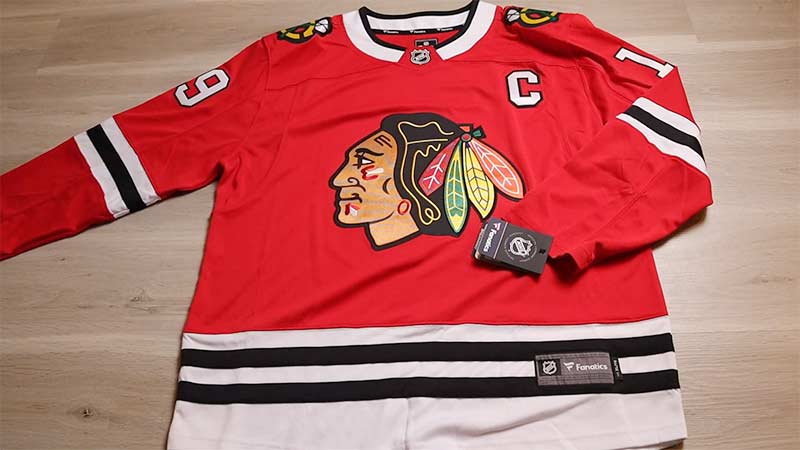Hockey jerseys serve as the iconic uniform on the ice, blending functionality with team identity.
The question of whether are hockey jerseys supposed to be big- why, delves into a nuanced balance between player comfort and on-ice performance.
From accommodating protective gear to adapting to diverse climates, the sizing of hockey jerseys is a carefully calibrated aspect of the sport.
In this exploration, we unravel the reasons behind the sizing choices, examining how they impact player safety, mobility, and the overall aesthetics of the game.
Understanding the significance of jersey size sheds light on the meticulous considerations that go into ensuring that every player feels both comfortable and equipped for optimal gameplay. Stay sharp.
Traditional Sizing of Hockey Jerseys
The sizing of hockey jerseys is a critical aspect of ensuring players’ comfort, mobility, and safety on the ice.
Traditional sizing methods have evolved over the years to accommodate the diverse body types and playing styles of hockey athletes.
In this context, let’s delve into some of the key points that highlight the significance of traditional sizing in hockey jerseys.
Player Mobility and Performance
Traditional sizing methods take into account the dynamic movements of hockey players on the ice. Jerseys are designed to provide enough room for players to maneuver, skate, and handle the puck effectively.
A well-fitted jersey enhances a player’s range of motion, allowing for swift and agile gameplay.
Protection and Safety
Properly sized jerseys contribute to player safety by ensuring that protective gear, such as shoulder pads and elbow pads, fits securely beneath the jersey.
This not only guards players against potential injuries but also prevents the interference of loose fabric with the equipment during intense gameplay.
Traditional sizing considers these factors to maintain a balance between protection and comfort.
Aesthetic and Team Identity
Hockey jerseys are not only functional but also serve as a visual representation of a team’s identity. Traditional sizing plays a crucial role in maintaining a uniform and professional appearance on the ice.
Ensuring that jerseys fit properly contributes to the overall aesthetic appeal of the team, fostering a sense of unity and pride among players and fans alike.
Adaptation to Climate Conditions
Hockey is played in a variety of climates, ranging from cold indoor arenas to outdoor rinks.
Traditional sizing takes into consideration the layering of clothing beneath the jersey to accommodate different weather conditions.
This adaptability ensures that players can regulate their body temperature effectively, whether they are playing in a heated arena or braving the elements in an outdoor game.
Fan Comfort and Merchandising
Beyond the players, traditional sizing also considers the comfort of fans who purchase replica jerseys.
Sizing options for fans are designed to replicate the on-ice look while providing a comfortable fit for everyday wear.
This not only enhances the fan experience but also contributes to the merchandising success of hockey jerseys, as fans are more likely to invest in apparel that mirrors the authentic look and feel of the game.
Are Hockey Jerseys Supposed to Be Big?

Hockey jerseys are not inherently supposed to be big; instead, their sizing is designed for a balance between mobility and protection.
The fit varies based on individual player preferences, team requirements, and the specific position played.
While some players may prefer a looser fit for increased mobility, others opt for a snug fit to enhance speed and agility.
The sizing ensures that the jersey accommodates necessary protective gear without compromising player movement.
It’s crucial to strike a balance, preventing jerseys from being excessively large to avoid interference with equipment while maintaining enough room for comfortable play.
The key consideration is that the jersey fits well enough to support optimal performance, protect against potential injuries, and align with the aesthetic identity of the team.
Reasons Why Are Hockey Jerseys Supposed to Be Big
The sizing of hockey jerseys tends to favor a slightly larger fit for several reasons, all aimed at optimizing player performance, safety, and overall functionality on the ice.
Protective Gear Accommodation
Hockey players wear essential protective gear such as shoulder pads, elbow pads, and chest protectors.
A slightly larger jersey allows ample room for these protective elements, ensuring they fit comfortably beneath the fabric without hindering a player’s range of motion.
Ease of Movement
While not excessively big, hockey jerseys are designed to provide players with freedom of movement. The slight looseness allows for swift and agile actions, contributing to better on-ice performance.
Players often prefer jerseys that do not restrict their motions, especially given the fast-paced nature of the sport.
Temperature Regulation
Hockey is played in various climates, and players may need to layer clothing for warmth, especially in colder environments.
A larger jersey accommodates additional layers, allowing players to regulate their body temperature effectively based on the playing conditions.
Physicality and Comfort
The physical nature of hockey, including body checks and collisions, necessitates jerseys that offer comfort and some level of padding.
A slightly bigger fit adds a layer of cushioning, reducing the impact of collisions and enhancing overall comfort during gameplay.
Team Unity and Aesthetic Appeal
Team unity and a cohesive visual identity are crucial in hockey. Slightly larger jerseys contribute to a uniform look, promoting a sense of solidarity among team members.
This aesthetic appeal not only fosters team spirit but also provides fans with a recognizable and consistent on-ice image, reinforcing the team’s brand and identity.
Functionality of Size in Hockey Jerseys

The functionality of size in hockey jerseys is a critical aspect that goes beyond mere aesthetics, encompassing player performance, safety, and the overall dynamics of the game.
Here are some key points that highlight the functional significance of sizing in hockey jerseys.
Optimized Range of Motion
The size of hockey jerseys is carefully considered to provide players with an optimized range of motion.
A well-fitted jersey allows for fluid movements, essential for actions such as skating, shooting, and puck handling. This functional aspect enhances a player’s agility and overall on-ice performance.
Accommodation of Protective Equipment
Hockey jerseys need to accommodate various pieces of protective equipment, including shoulder pads, elbow pads, and chest protectors.
The sizing is designed to ensure that these essential protective elements fit comfortably beneath the jersey, offering the necessary safeguard without impeding the player’s mobility.
Climate Adaptability
Sizing takes into account the diverse climates in which hockey is played. From indoor arenas to outdoor rinks, players may need to adjust their clothing layers.
The functional size of jerseys allows players to regulate their body temperature effectively by layering clothing for warmth or opting for a lighter configuration in warmer conditions.
Prevention of Interference
An appropriately sized jersey helps prevent interference during gameplay.
Excessively large jerseys may pose the risk of getting caught on equipment or opponents, potentially affecting the player’s performance and safety.
Functional sizing strikes a balance, providing enough room for movement without compromising on the risk of interference.
Team Cohesion and Visual Identity
The functionality of jersey size extends to team cohesion and visual identity. Uniform sizing contributes to a cohesive team appearance, reinforcing a sense of unity among players.
This functional aspect is essential for creating a recognizable and consistent on-ice image, strengthening the team’s brand, and fostering a collective team identity.
Impact of Large-Size Jerseys on Player Safety
While the sizing of hockey jerseys is carefully considered to balance mobility and protection, the impact of large-size jerseys on player safety is a crucial aspect that merits examination.
Here are some of the key points that delve into the implications of oversized jerseys on the safety of hockey players.
Risk of Equipment Interference
Large-size jerseys increase the risk of equipment interference during gameplay. Loose fabric may become entangled with opponents’ sticks or other players, posing a safety hazard.
This interference can disrupt a player’s movements, increasing the likelihood of falls or collisions on the ice.
Limited Visibility of Protective Gear
An excessively large jersey may obscure the visibility of essential protective gear, such as shoulder pads and chest protectors.
This limitation can compromise the effectiveness of the gear in providing adequate protection against impacts and injuries, potentially putting players at greater risk during physical play.
Compromised Impact Absorption
Properly fitted jerseys contribute to the overall effectiveness of protective equipment by allowing it to function as intended.
Oversized jerseys may compromise the ability of equipment, such as shoulder pads, to absorb impacts effectively.
This reduction in impact absorption can expose players to a higher risk of injury during collisions or body checks.
Impaired Agility and Reaction Time
Large jerseys can impede a player’s agility and reaction time. The excess fabric may restrict movement, making it challenging for players to respond quickly to changing game situations.
This impairment in agility and reaction time not only affects overall performance but also increases the susceptibility to injuries, especially in fast-paced and physically demanding hockey games.
Uniformity in Safety Standards
Consistency in jersey sizing is essential for maintaining uniform safety standards across the sport. When jerseys are appropriately sized, it ensures that players across different teams adhere to similar safety guidelines.
This consistency promotes a safer playing environment and reduces the potential for avoidable injuries arising from irregularities in jersey sizes.
FAQs
Are hockey jerseys meant to be loose or tight?
Hockey jerseys are designed to provide a balance between mobility and protection.
While not excessively loose, they offer enough room for players to move comfortably.
The fit can vary based on personal preference and playing position.
Why do hockey players wear slightly oversized jerseys?
Slightly oversized hockey jerseys accommodate protective gear like shoulder pads and elbow pads.
This ensures a comfortable fit without restricting movement, contributing to player safety and allowing for optimal performance on the ice.
Do larger hockey jerseys impact player performance?
Yes, excessively large jerseys can impact performance. They may lead to equipment interference, limit the visibility of protective gear, and hinder agility.
A balance in size is essential to maintain optimal player performance, safety, and overall functionality during gameplay.
How do hockey jerseys adapt to different climates?
Hockey jerseys are designed to adapt to various climates. Sizing allows players to layer clothing for warmth in colder conditions or opt for a lighter configuration in warmer arenas.
This adaptability ensures comfort and temperature regulation during diverse playing environments.
Is there a standard size for hockey jerseys?
While there is no universal standard, hockey jerseys follow team-specific sizing guidelines.
These guidelines consider factors such as player preferences, position-specific requirements, and the need to accommodate protective equipment.
The goal is to achieve a balance between a comfortable fit and functional performance.
Wrapping Up
In the world of hockey, the size of jerseys goes beyond mere aesthetics; it is a dynamic factor influencing player safety and performance. Finding the right balance between comfort and functionality is paramount.
As we’ve uncovered, hockey jerseys are not merely big for the sake of fashion; they are crafted to enhance mobility, accommodate protective gear, and adapt to diverse playing conditions.
The next time you see a player donning a slightly larger jersey, recognize it as a strategic choice aimed at fostering a seamless blend of style and substance on the hockey rink. Thank you so much.








James Felix